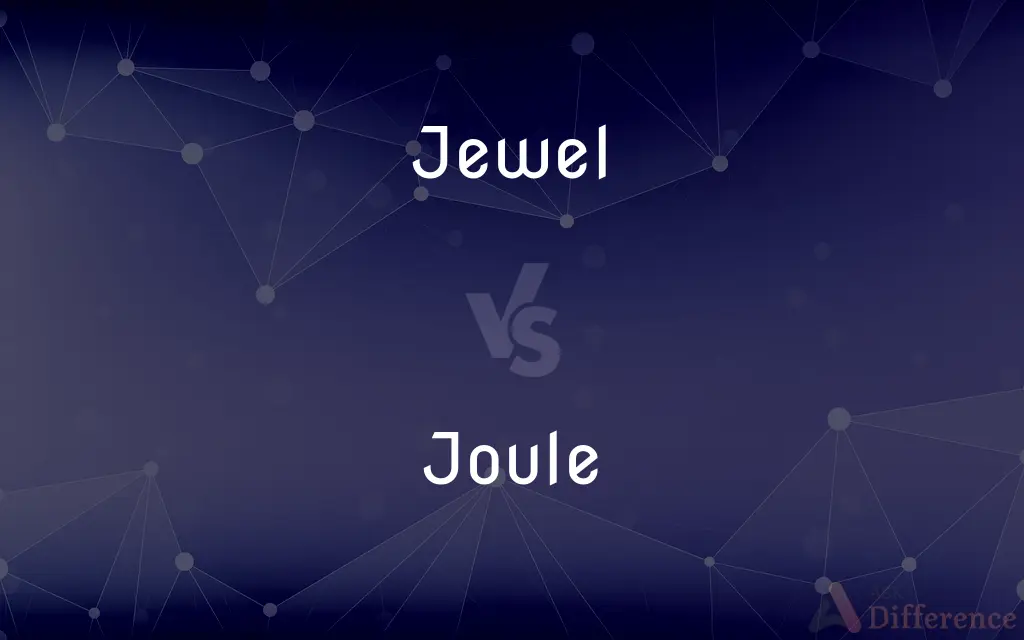Jewel vs. Joule — What's the Difference?
By Urooj Arif & Maham Liaqat — Updated on March 31, 2024
A jewel refers to a precious stone or gem used for adornment, symbolizing wealth and beauty, while a joule is a unit of energy in the International System of Units, representing the amount of work done when a force of one newton moves an object one meter.

Difference Between Jewel and Joule
Table of Contents
ADVERTISEMENT
Key Differences
Jewels are valuable stones like diamonds, rubies, and emeralds, often cut and polished for use in jewelry to enhance aesthetic appeal and signify status. They are mined from the earth and can vary widely in color, size, and rarity, factors that determine their value. Whereas, a joule is a scientific term, a unit of measurement for energy, work, or amount of heat. It quantifies energy transfer in terms of physical work, electrical power, or heat, playing a critical role in physics, engineering, and various fields of science and technology.
In their respective contexts, jewels serve as symbols of beauty, wealth, or power, often passed down through generations as heirlooms. On the other hand, joules are integral to understanding and calculating energy efficiency, consumption, and production in practical applications ranging from electrical appliances to physical exercises and beyond.
The value of jewels is determined by market demand, rarity, and intrinsic qualities such as clarity, color, cut, and carat weight. Conversely, the significance of joules lies in their ability to quantify and compare energy usage or production across different systems and processes, providing a universal standard for energy measurement.
While jewels are subject to trends, fashion, and personal taste, influencing their design and usage in jewelry and adornments, joules are defined by physical laws and principles, unaffected by trends or subjective views. This distinction highlights jewels' cultural and aesthetic importance versus joules' fundamental role in science and technology.
The handling and trade of jewels require expertise in gemology and a deep understanding of the jewelry market, whereas knowledge of joules and their application demands proficiency in physics and engineering, showcasing the diverse expertise required in both fields.
ADVERTISEMENT
Comparison Chart
Definition
A precious stone cut and polished for adornment.
A unit of energy in the International System of Units.
Significance
Symbolizes wealth, beauty, and status.
Measures energy, work, or heat.
Determinants of Value
Rarity, color, clarity, cut, carat weight.
Used to quantify and compare energy efficiency and consumption.
Field of Use
Jewelry making, fashion, and adornment.
Physics, engineering, technology, and energy management.
Influence
Subject to trends, fashion, and personal taste.
Defined by physical laws, universal across contexts.
Expertise Required
Gemology and jewelry market knowledge.
Physics and engineering understanding.
Compare with Definitions
Jewel
Cut and polished stone for adornment.
The artisan skillfully cut the diamond into a brilliant jewel.
Joule
Unit of energy measurement.
One joule is the energy used to lift a small apple one meter up.
Jewel
Valued based on rarity and quality.
The rarity of the jewel added immensely to its value.
Joule
Fundamental in physics and engineering.
Engineers calculate energy in joules to design efficient machines.
Jewel
Symbol of wealth and beauty.
Royals have adorned their crowns with jewels for centuries.
Joule
Universal measurement standard.
Joules provide a common language for discussing energy across various fields.
Jewel
Part of cultural and fashion trends.
The jewel trend this season includes vibrant colored gemstones.
Joule
Quantifies work, energy, and heat.
The light bulb consumes 60 joules of energy per second.
Jewel
Precious gemstone used in jewelry.
The necklace featured a large emerald jewel.
Joule
Critical for energy management.
Reducing a device's consumption by a few joules can save significant energy over time.
Jewel
A precious stone; a gem.
Joule
The joule ( jowl, jool; symbol: J) is a derived unit of energy in the International System of Units. It is equal to the energy transferred to (or work done on) an object when a force of one newton acts on that object in the direction of the force's motion through a distance of one metre (1 newton-metre or N⋅m).
Jewel
A small natural or artificial gem used as a bearing in a watch.
Joule
The International System unit of electrical, mechanical, and thermal energy, equal to the work done when a force of one newton acts through a distance of one meter, and also equal to the work done when a current of one ampere is passed through a resistance of one ohm for one second.
Jewel
A costly ornament of precious metal or gems.
Joule
In the International System of Units, the derived unit of energy, work and heat; the work required to exert a force of one newton for a distance of one metre. Equivalent to one watt of power for a duration of one second. Symbol: J
Jewel
One that is treasured or esteemed.
Joule
A unit of work which is equal to 107 ergs (the unit of work in the C. G. S. system of units), and is equivalent to one watt-second, the energy expended in one second by an electric current of one ampere in a resistance of one ohm; also called the absolute joule. It is abbreviated J or j. The international joule is slightly larger, being 1.000167 times the absolute joule. The absolute joule is approximately equal to 0.737562 foot pounds, 0.239006 gram-calories (small calories), and 3.72506 x 10-7 horsepower-hours, and 0.000948451 B.t.u.
Jewel
To adorn with jewels.
Joule
A unit of electrical energy equal to the work done when a current of one ampere passes through a resistance of one ohm for one second
Jewel
To fit with jewels.
Joule
English physicist who established the mechanical theory of heat and discovered the first law of thermodynamics (1818-1889)
Jewel
A precious or semi-precious stone; gem, gemstone.
Jewel
A valuable object used for personal ornamentation, especially one made of precious metals and stones; a piece of jewellery.
Jewel
(figuratively) Anything precious or valuable.
Galveston was the jewel of Texas prior to the hurricane.
Jewel
(horology) A bearing for a pivot in a watch, formed of a crystal or precious stone.
Jewel
Any of various lycaenid butterflies of the genus Hypochrysops.
Jewel
(slang) The clitoris.
Jewel
To bejewel; to decorate or bedeck with jewels or gems.
Jewel
An ornament of dress usually made of a precious metal, and having enamel or precious stones as a part of its design.
Plate of rare device, and jewelsOf rich and exquisite form.
Jewel
A precious stone; a gem.
Jewel
An object regarded with special affection; a precious thing.
Jewel
A bearing for a pivot a pivot in a watch, formed of a crystal or precious stone, as a ruby.
Jewel
To dress, adorn, deck, or supply with jewels, as a dress, a sword hilt, or a watch; to bespangle, as with jewels; to bejewel.
The long gray tufts . . . are jeweled thick with dew.
Jewel
A precious or semiprecious stone incorporated into a piece of jewelry
Jewel
A person who is a brilliant and precious as a piece of jewelry
Jewel
Adorn or decorate with precious stones;
Jeweled dresses
Common Curiosities
Can the value of a jewel change over time?
Yes, the value of a jewel can change due to market demand, fashion trends, and the discovery of new deposits, affecting its rarity and desirability.
How are jewels valued?
Jewels are valued based on factors like rarity, color, clarity, cut, and carat weight, which determine their market price and desirability.
What is the importance of joules in everyday life?
Joules are important for understanding energy consumption and efficiency in everyday appliances, allowing for better energy management and conservation.
How do you calculate joules?
Joules can be calculated based on the amount of work done or energy transferred, using the formula joule = newton meter, among other methods in specific contexts.
Why are joules a universal unit of measurement?
Joules are a universal unit because they are part of the International System of Units, recognized and used worldwide for scientific and practical energy measurements.
What is the difference between joules and calories?
Joules and calories are both units of energy, but they are used in different contexts; joules are the SI unit for energy, while calories are often used to measure the energy content in food.
Can the color of a jewel affect its value?
Yes, the color of a jewel can greatly affect its value; unique, vibrant, and highly sought-after colors can increase a gemstone's price.
What makes a jewel precious?
A jewel becomes precious based on its rarity, aesthetic appeal, durability, and the demand within the market.
In what units are joules divided or multiplied?
Joules can be divided into smaller units like millijoules (mJ) or multiplied into larger units like kilojoules (kJ) for convenience in various scales of measurement.
How is the concept of joules applied in renewable energy?
In renewable energy, joules are used to measure the amount of energy produced or saved by technologies like solar panels and wind turbines, highlighting their efficiency and impact.
What does a joule measure?
A joule measures energy, work, or heat, representing the amount of work done when a force of one newton moves an object one meter.
What is a jewel?
A jewel is a precious or semi-precious stone that has been cut and polished for use in jewelry, symbolizing beauty and wealth.
Are all jewels expensive?
Not all jewels are expensive; their price varies widely depending on the type, quality, and market demand for the stone.
How do trends affect jewel values?
Trends can significantly affect jewel values, as demand for certain colors, cuts, or types of stones can raise their desirability and market price.
What expertise is required to work with jewels?
Working with jewels requires knowledge in gemology, understanding of the jewelry market, and skills in jewelry design and craftsmanship.
Share Your Discovery

Previous Comparison
Underwear vs. Undershorts
Next Comparison
Christians vs. MuslimsAuthor Spotlight
Written by
Urooj ArifUrooj is a skilled content writer at Ask Difference, known for her exceptional ability to simplify complex topics into engaging and informative content. With a passion for research and a flair for clear, concise writing, she consistently delivers articles that resonate with our diverse audience.
Co-written by
Maham Liaqat













































